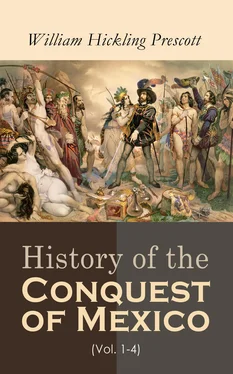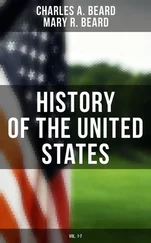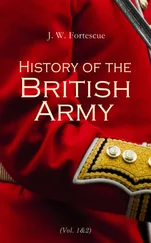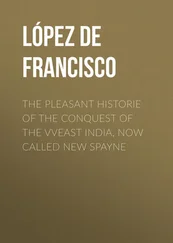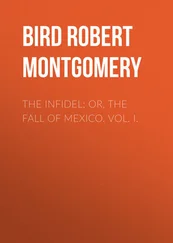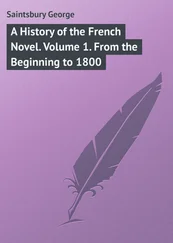Among the most important articles of husbandry, we may notice the banana, whose facility of cultivation and exuberant returns are so fatal to habits of systematic and hardy industry. [215]Another celebrated plant was the cacao, the fruit of which furnished the chocolate,—from the Mexican chocolatl ,—now so common a beverage throughout Europe. [216]The vanilla, confined to a small district of the sea-coast, was used for the same purposes, of flavoring their food and drink, as with us. [217]The great staple of the country, as, indeed, of the American continent, was maize, or Indian corn, [218]which grew freely along the valleys, and up the steep sides of the Cordilleras to the high level of the table-land. The Aztecs were as curious in its preparation, and as well instructed in its manifold uses, as the most expert New England housewife. Its gigantic stalks, in these equinoctial regions, afford a saccharine matter, not found to the same extent in northern latitudes, and supplied the natives with sugar little inferior to that of the cane itself, which was not introduced among them till after the Conquest. [219]But the miracle of nature was the great Mexican aloe, or maguey , whose clustering pyramids of flowers, towering above their dark coronals of leaves, were seen sprinkled over many a broad acre of the table-land. As we have already noticed, its bruised leaves afforded a paste from which paper was manufactured; [220]its juice was fermented into an intoxicating beverage, pulque , of which the natives, to this day, are excessively fond; [221]its leaves further supplied an impenetrable thatch for the more humble dwellings; thread, of which coarse stuffs were made, and strong cords, were drawn from its tough and twisted fibres; pins and needles were made of the thorns at the extremity of its leaves; and the root, when properly cooked, was converted into a palatable and nutritious food. The agave , [222]in short, was meat, drink, clothing, and writing-materials, for the Aztec! Surely, never did Nature enclose in so compact a form so many of the elements of human comfort and civilization! [223]
It would be obviously out of place to enumerate in these pages all the varieties of plants, many of them of medicinal virtue, which have been introduced from Mexico into Europe. Still less can I attempt a catalogue of its flowers, which, with their variegated and gaudy colors, form the greatest attraction of our greenhouses. The opposite climates embraced within the narrow latitudes of New Spain have given to it, probably, the richest and most diversified flora to be found in any country on the globe. These different products were systematically arranged by the Aztecs, who understood their properties, and collected them into nurseries, more extensive than any then existing in the Old World. It is not improbable that they suggested the idea of those “gardens of plants” which were introduced into Europe not many years after the Conquest. [224]
The Mexicans were as well acquainted with the mineral as with the vegetable treasures of their kingdom. Silver, lead, and tin they drew from the mines of Tasco; copper from the mountains of Zacotollan. These were taken not only from the crude masses on the surface, but from veins wrought in the solid rock, into which they opened extensive galleries. In fact, the traces of their labors furnished the best indications for the early Spanish miners. [225]Gold, found on the surface, or gleaned from the beds of rivers, was cast into bars, or, in the form of dust, made part of the regular tribute of the southern provinces of the empire. The use of iron, with which the soil was impregnated, was unknown to them. Notwithstanding its abundance, it demands so many processes to prepare it for use that it has commonly been one of the last metals pressed into the service of man. The age of iron has followed that of brass, in fact as well as in fiction. [226]
They found a substitute in an alloy of tin and copper, and, with tools made of this bronze, could cut not only metals, but, with the aid of a silicious dust, the hardest substances, as basalt, porphyry, amethysts, and emeralds. [227]They fashioned these last, which were found very large, into many curious and fantastic forms. They cast, also, vessels of gold and silver, carving them with their metallic chisels in a very delicate manner. Some of the silver vases were so large that a man could not encircle them with his arms. They imitated very nicely the figures of animals, and, what was extraordinary, could mix the metals in such a manner that the feathers of a bird, or the scales of a fish, should be alternately of gold and silver. The Spanish goldsmiths admitted their superiority over themselves in these ingenious works. [228]
They employed another tool, made of itztli , or obsidian, a dark transparent mineral, exceedingly hard, found in abundance in their hills. They made it into knives, razors, and their serrated swords. It took a keen edge, though soon blunted. With this they wrought the various stones and alabasters employed in the construction of their public works and principal dwellings. I shall defer a more particular account of these to the body of the narrative, and will only add here that the entrances and angles of the buildings were profusely ornamented with images, sometimes of their fantastic deities, and frequently of animals. [229]The latter were executed with great accuracy. “The former,” according to Torquemada, “were the hideous reflection of their own souls. And it was not till after they had been converted to Christianity that they could model the true figure of a man.” [230]The old chronicler’s facts are well founded, whatever we may think of his reasons. The allegorical phantasms of his religion, no doubt, gave a direction to the Aztec artist, in his delineation of the human figure; supplying him with an imaginary beauty in the personification of divinity itself. As these superstitions lost their hold on his mind, it opened to the influences of a purer taste; and, after the Conquest, the Mexicans furnished many examples of correct, and some of beautiful, portraiture.
Sculptured images were so numerous that the foundations of the cathedral in the plaza mayor , the great square of Mexico, are said to be entirely composed of them. [231]This spot may, indeed, be regarded as the Aztec forum,—the great depository of the treasures of ancient sculpture, which now lie hid in its bosom. Such monuments are spread all over the capital, however, and a new cellar can hardly be dug, or foundation laid, without turning up some of the mouldering relics of barbaric art. But they are little heeded, and, if not wantonly broken in pieces at once, are usually worked into the rising wall or supports of the new edifice. [232]Two celebrated bas-reliefs of the last Montezuma and his father, cut in the solid rock, in the beautiful groves of Chapoltepec, were deliberately destroyed, as late as the eighteenth century, by order of the government! [233]The monuments of the barbarian meet with as little respect from civilized man as those of the civilized man from the barbarian. [234]
The most remarkable piece of sculpture yet disinterred is the great calendar stone, noticed in the preceding chapter. It consists of dark porphyry, and in its original dimensions, as taken from the quarry, is computed to have weighed nearly fifty tons. It was transported from the mountains beyond Lake Chalco, a distance of many leagues, over a broken country intersected by watercourses and canals. In crossing a bridge which traversed one of these latter, in the capital, the supports gave way, and the huge mass was precipitated into the water, whence it was with difficulty recovered. The fact that so enormous a fragment of porphyry could be thus safely carried for leagues, in the face of such obstacles, and without the aid of cattle,—for the Aztecs, as already mentioned, had no animals of draught,—suggests to us no mean ideas of their mechanical skill, and of their machinery, and implies a degree of cultivation little inferior to that demanded for the geometrical and astronomical science displayed in the inscriptions on this very stone. [235] [236]
Читать дальше
